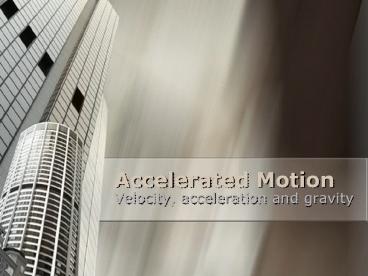Accelerated Motion - PowerPoint PPT Presentation
1 / 48
Title:
Accelerated Motion
Description:
Change in position with respect to time. v = ?d/?t. Which can be written as: ... Hypotenuse. Gravity. Frictionless Car Plots. Good Reading on Plot ... – PowerPoint PPT presentation
Number of Views:51
Avg rating:3.0/5.0
Title: Accelerated Motion
1
Accelerated Motion
- Velocity, acceleration and gravity
2
How fast do things fall
3
Reflexes
4
Position-Time Graphs
1
2
3
4
5
Velocity v. Time
6
Definitions
- Velocity
- Change in position with respect to time
- v ?d/?t
- Which can be written as
- (dfinal-dinitial)/(tfinal-tinitial)
- Common notation
- (dfdi)/(tfti)
- Acceleration
- Change in velocity with respect to time
- a ?v/?t
- Which can be written as
- (vfinal-vinitial)/(tfinal-tinitial)
- Common notation
- (vfvi)/(tfti)
7
Velocity to Acceleration
- v?d/?t(dfinaldinitial)/(tfinaltinitial)
- a?v/?t(vfinalvinitial)/(tfinaltinitial)
8
(No Transcript)
9
Average Acceleration
- a ?v/?t(vfinalvinitial)/(tfinaltinitial)
- f final
- i initial
- If tinitial 0
- a (vfinal vinitial)/tfinal
- Or
- vf vi atf
10
Positive and Negative Acceleration
11
Practice Problem
- A soccer player is running at a constant velocity
of 50.0km/h (31mph). The player falls and skids
to a halt in 4.0 seconds. - What is the average acceleration of the player
during the skid? - What is the plot of the velocity vs. time?
12
Practice Problem
- A water balloon in the sling of a water balloon
launcher undergoes a constant acceleration
25m/s2 for 1.5s. - What is the velocity of the water balloon right
after launch?
13
Practice Problem
- A car accelerates from rest at 5 m/s2 for 5
seconds. It moves with a constant velocity for
some time, and then decelerates at 5 m/s2 to come
to rest. The entire journey takes 25 seconds.
Plot the velocity-time graph of the motion.
14
Practice Problem
Determine the accelerations for a1, a2, a3, and
a4 for each time interval.
a1 4/5 a2 (4-4)/(10-5) a3 (16-4)/(20-10) a4
(0-16)/(30-20)
15
Frictionless Cars
16
Frictionless Car Plots
17
Good Reading on Plot
18
Velocity with Constant Acceleration
- Given
- Solve
- for tf
- Substitute in
- Yeilds
19
Velocity with Constant Acceleration
- Solve for vf
2
½
2
1
1
½
2
2
1
2
1
2
2
2
2
2
2
2
2
2
2
2
2
2
20
Graphs
- Determine which equations provide the area under
the graph. (let ti 0)
(vf-vi)
(tf-ti)
½
1)
Velocity (m/s)
2
2)
tf
a
½
3)
(vf-vi)
2
1
(tf-ti)
(tf-ti)
2
Time (s)
21
Velocity with Constant Acceleration
- Equation to remember
- vf2 vi2 2a(df-di)
22
Position with Average Acceleration
- ?d/?t ?v ½ a ?t
- ?d ?v?t ½ a ?t2
- When ti 0
- df - di vitf ½ atf2
23
Position with Average Acceleration
- Equation to remember
- Final position initial position (change in
velocity)time ½ (acceleration)(time squared) - df di (vf-vi)t ½ at2
24
Table 3-3 Page 68
- Equations of Motion for Uniform Acceleration
Equation Variables Initial Conditions
Average Acceleration tf,vf,a vi
Velocity with Constant Acceleration tf,df,a di,vi
Position with Average Acceleration df,vf,a di,vi
25
Free Fall on the Moon
26
Free Fall on the Moon
27
Group Project pg 78
- How fast is the Earth spinning?
- 0.5 km/sec
- How fast is the Earth revolving around the Sun?
- 30 km/sec
- How fast is the Solar System moving around the
Milky Way Galaxy? - 250 km/sec
- How fast is our Milky Way Galaxy moving in the
Local Group of galaxies? - 370 km/sec
28
Free Fall
- All Objects fall at the same speed regardless of
mass (if you can neglect wind resistance).
29
Free Fall
- A ball or a bullet?
- .
- .
Position with Average Acceleration
Height with constant gravity
30
Falling
31
Poor little guy
32
Graphs
33
Cart Movement
34
Practice Problems
- If you throw a ball straight upward, it will rise
into the air and then fall back down toward the
ground. - Imagine that you throw the ball with an initial
velocity of 10.0 m/s. - a. How long does it take the ball to reach the
top of its motion? - b. How far will the ball rise before it begins to
fall? - c. What is its average velocity during this
period?
35
a. How long does it take the ball to reach the
top of its motion?
36
b. How far will the ball rise before it begins to
fall?
37
c. What is its average velocity during this
period?
38
Practice Problem
- A sudden gust of wind increases the velocity of a
sailboat relative to the water surface from 3.0
m/s to 5.5 m/s over a period of 60.0 s. - a. What is the average acceleration of the
sailboat? - b. How far does the sailboat travel during the
period of acceleration?
39
a. What is the average acceleration of the
sailboat?
40
b. How far does the sailboat travel during the
period of acceleration?
41
Practice Problem
- A car starts from rest with an acceleration of
4.82 m/s2 at the instant when a second car
moving with a velocity of 44.7 m/s (100mph by the
way) passes it in a parallel line. How far does
the first car move before it overtakes the second
car? - Setup an equation or graph
42
Setup the equation
0
0
43
(No Transcript)
44
Positiond
45
Velocityv?d/?t
46
Accelerationa?v/?t
47
(No Transcript)
48
(No Transcript)































